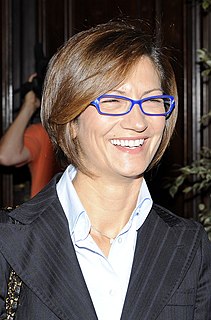
The Accademia di Belle Arti di Firenze is an instructional art academy in Florence, in Tuscany, in central Italy.

Radio Radicale is the official radio station of the Italian Radical Party. Founded in 1976 as part of the Radio libere movement, it has no commercial advertisements and is partly funded by the party, with support from the Italian government as part of an agreement for the broadcasting of Parliamentary sessions.

First Marshal of the Empire was a military rank established by the Italian Parliament on March 30, 1938. The highest rank in the Italian military, it was only granted to King Victor Emmanuel III and Duce Benito Mussolini.

The Ministry of Defence is the government body of the Italian Republic responsible for military and civil defence matters and managing the Italian Armed Forces. It is led by the Italian Minister of Defence, a position occupied by Guido Crosetto since October 2022.

The Ministry of Culture is the ministry of the Government of Italy in charge of national museums and the monuments historiques. MiC's headquarters are located in the historic Collegio Romano Palace and the current Minister of Culture is Dario Franceschini.

The Dipartimento delle Informazioni per la Sicurezza is a department of the Presidency of the Council of Ministers of Italy, instituted in 2007 as part of the reform of the Italian security services. The department is part of Sistema di informazione per la sicurezza della Repubblica. It is currently headed by Elisabetta Belloni, the successor to General Gennaro Vecchione.

The Ministry of Economics and Finance, also known by the acronym MEF, is a ministry of the Italian government. Its responsibilities include overseeing economic policy, public investments and spending. The Ministry's headquarters are located in Rome's historic Palazzo delle Finanze. The current minister in the Meloni Cabinet is Giancarlo Giorgetti.
The Automobile Club d'Italia is a not-for-profit statutory corporation of the Italian Republic. The club originated through the efforts of Count Carlo Biscaretti di Ruffia as the "Automobile Club of Turin" founded in Turin on 6 December 1898. It first became a national association in 1905 when it joined together with other local automotive clubs. In 1927 the corporate body was formed by royal decree, with the task of promoting and regulating the car sector and to represent car owners' interests in the country.
The Polizia Postale e delle Comunicazioni is one of the units of the Polizia di Stato, the State Police of Italy. Its functions include the investigation of cybercrime.
The Direzione Investigativa Antimafia, also known as DIA, is an Italian multi-force investigation body under the Department of Public Security of the Ministry of the Interior. Its main task is the fight against the mafia-related organized crime in Italy.
Cassa di Risparmio del Veneto S.p.A., known as CR Veneto, was an Italian savings bank, headquartered in Padua, Veneto. It was a subsidiary of Intesa Sanpaolo.
Cassa di Risparmio del Friuli Venezia Giulia S.p.A. known as CariFVG in short, was an Italian savings bank based in Gorizia, Friuli – Venezia Giulia region.

INA Assitalia S.p.A. was an insurance company, operating on the Italian market from 1912 to 2013. In the last years it belonged to the Assicurazioni Generali group.
The Istituto Nazionale per l'Assicurazione contro gli Infortuni sul Lavoro or INAIL is an Italian statutory corporation overseen by the Ministry of Labour and Social Policies. Its headquarters is in the INAIL Tower in the EUR, Rome.

Cassa di Risparmio della Marca Trivigiana also known as Cassamarca in short, was an Italian savings bank headquartered in Treviso, Veneto. Due to Legge Amato, the bank was split into two organizations: Cassamarca S.p.A. and Fondazione Cassamarca – Cassa di Risparmio della Marca Trivigiana in 1992. The S.p.A. and the banking foundation were the founders of banking group Unicredito in 1994, a predecessor of UniCredit. The S.p.A. was absorbed into UniCredit in 2002; the banking foundation, survived as a charity organization, as well as owned 0.23% shares of UniCredit, as one of its investments.
The fusion of Italian municipalities is the physical-territorial union between two or more contiguous comuni.

The Gelmini reform refers to the set of acts of the Italian Republic – issued during the Berlusconi IV Cabinet – concerning the education sector in Italy.

A Ministry of the Republic of Italy is an administrative organ of the Republic of Italy, placed at the top of Italian public administration and is characterised by one or more specific competencies, with an organised structure, often varying over time.

The Istituto nazionale della previdenza sociale is the main entity of the Italian public retirement system. All waged labourers and most of self-employed, without a proper autonomous social security fund, must be subscribed to INPS. The entity is under the supervision of the Ministry of Labour and Social Policies.
Unione radiofonica italiana or URI, was an Italian radio broadcaster founded in Turin on 27 August 1924. It was the exclusive radio broadcaster of the Kingdom of Italy.













